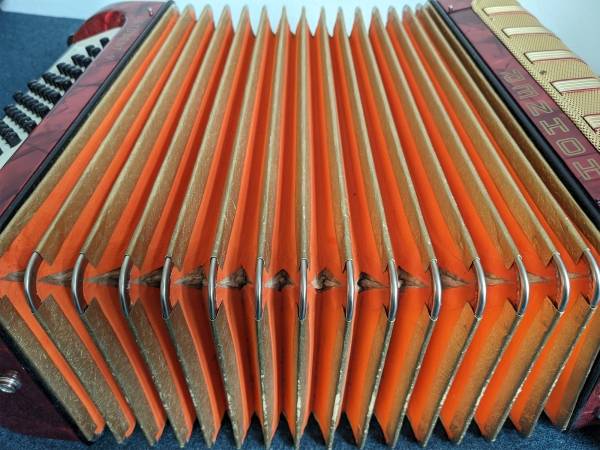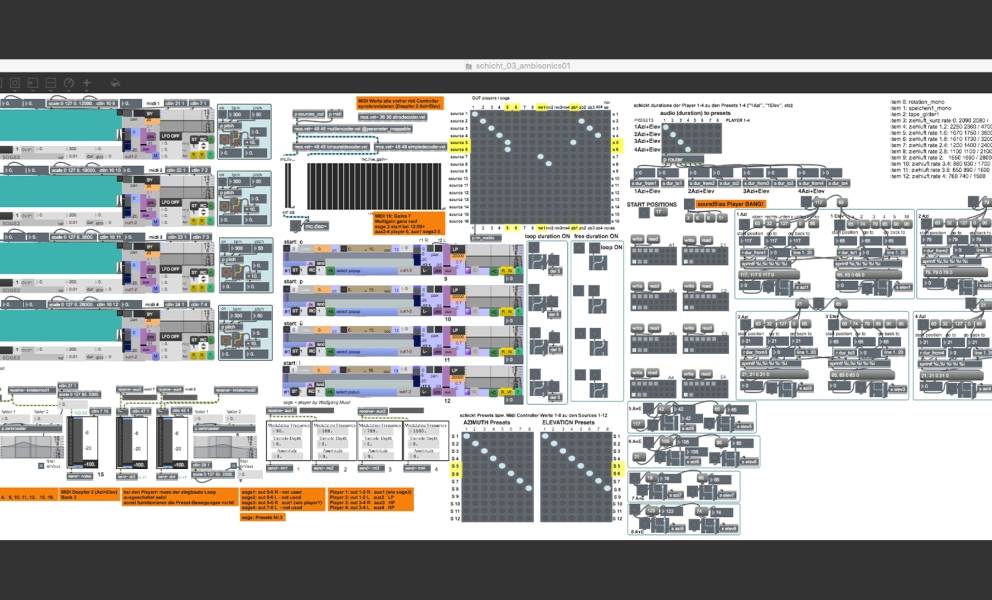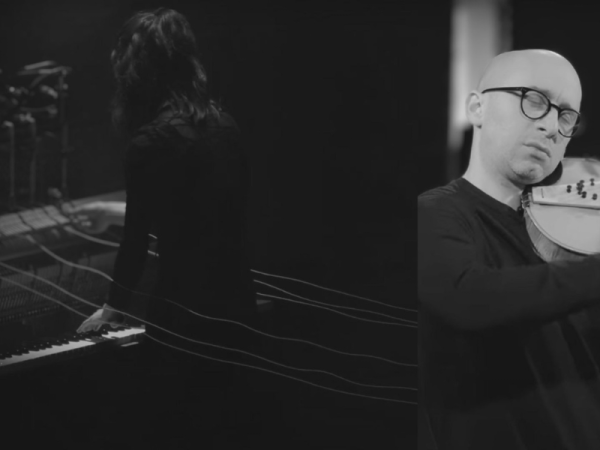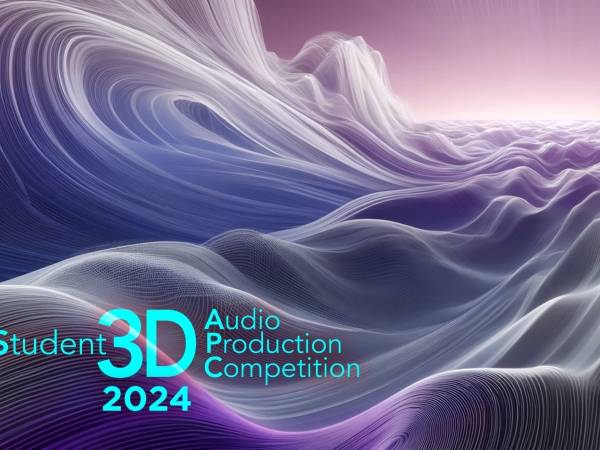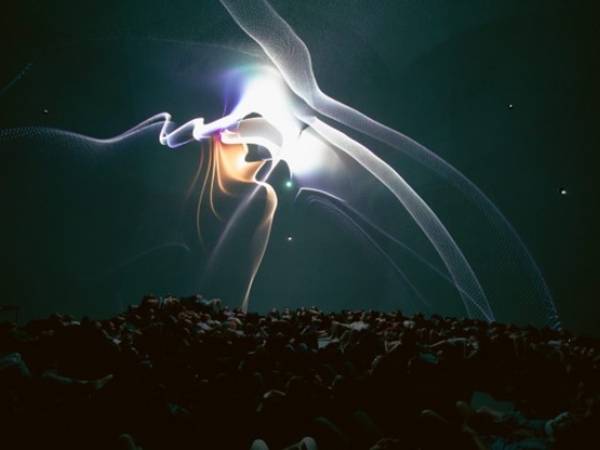6 Minuten
momentum I – Search
In Newtonian mechanics, momentum [...] is the product of the mass and velocity of an object. 1
momentum is the title of my first live performance with Ambisonics. I was looking for the "right" sound: a sound that carries a spatial aspect and a movement within it. I wanted a sound that could express its inherent space and movement even before it was processed with digital tools for spatialization. Spatialization, and ambisonics, should then reinforce, emphasize, and represent precisely these already perceptible characteristics of the sound and not artificially turn it into something it is not.
Sound has space. Why Ambisonics?
My practical approach to the topic of Ambisonics began with precisely this motivation: Ambisonics is not used to record a sound field and reproduce it spatially as faithfully as possible, but to approach the matter from a different angle: Sounds transmit physicality and spatial parameters such as proximity, distance and movement through their spectral and morphological properties. In practice, the spatialization of a sound object only takes place afterward. In the first step, a (quasi-spatially dimensionless) sound should therefore determine by itself which space it needs. I then investigate how I can support the perception of this spatiality with the help of Ambisonics.
Sounds that do not initially have 3D audio properties when played back in standard stereo are, for example, digitally generated sounds that are produced without special spatial characteristics. They can also be mono or stereo recordings. Why are these sounds subsequently equipped with an artificial three-dimensional space? What musical purpose can this serve? Are there aspects that go beyond creating an immersive listening experience?
My conclusion: For the Ambisonics format to be musically essential, I first need the right sound. What requirements does a sound have to fulfill, and what characteristics should it have? Are there certain sounds or noises that are better suited to 3D audio than others
momentum II – Perception
Air, scratchy noise, a back-and-forth movement, a waxing and waning, an approach, and a distance. In the loop: Heard as a regular rhythm, a pulse, an association with breathing. A sequence of movements, a physical sensation. A body of sound in the figurative sense.
It is the recording of the bellows of an accordion: opening and closing, pulling apart and pushing together: the (air) sound of a movement.
The audio recording was made so long ago that I can no longer remember the exact conditions of the recording. With which microphone? In which room? It was certainly not a professional recording with a stereo pair and not a 3D-capable microphone, but rather a small recording device with a built-in microphone, made in the living room.
This sample of the accordion below is a suitable sound for me, full of its own space and articulated movement. An ideal starting point to delve into the given sound morphology and to experiment with the means of Ambisonics.
Tangible spaces
The idea of understanding Ambisonics as a tool for sound processing and not primarily as a spatial tool, especially in the recording and playback process, has stayed with me. When I talk about sound processing in this context, it is in the sense that I influence the possible perception, effect, and understanding of a sound. For example, whether I experience it only on the left, only on the right, in a movement from left to right, quadraphonically, or as a tangible 3D object is important. With the help of Ambisonics, I can create the sense of space that a sound conveys - and that is something different from the "real" three-dimensional space of a recording! -, the plastic, the haptic, even more clearly and make it intensely tangible. Ambisonics can be used to support and reinforce the inherent movement of a sound that already contains movement or calls for movement (far more intensively than in a pure multi-channel setting).
momentum III – Realization
Although I know the sound source of my sample, my first association when listening to the recording of the accordion below was human breath, something alive. I needed a means by which the inner movement of the sample, my association of breathing, and this lively pulsating space could be carried and represented. It had to be more than just moving from left to right. An intense physical experience, conceived as a three-dimensional sound object that becomes physically tangible and understandable in its unconditionality - and my interpretation of it as a vital necessity.
I realized momentum with the software Max/MSP and IEM plugins for Ambisonics.
The original recording is 6 seconds long. Using time compression, I created different versions that are shorter than the original, between 1 and 5 seconds. The back-and-forth movement, the pulse, the breathing is accelerated. In the course of the performance, I adapted the speed of the movements in the 3D field to the duration of the samples: The different trajectories follow the tempos or the respective durations of the opening and closing of the bellows, the inhalation, and exhalation. The spatial expansion of the sounds, the occupation of the 3D field, changes with the movement paths.
Spatial enlargements, reductions, and different complexities of the movement paths become formative means for intensifying the perception of sound. In these processes, in which I assign Ambisonics a supporting role for space and movement, these are the most important performative elements. Through its spectral properties and (subjective) associations, sound provides the framework for space and movement; tools for spatialization, in this case, Ambisonics, serve the properties of sound.
Furthermore, in momentum I worked with sonic alienation similar to distortion. From this alienation and density of samples in overlapping spaces, the originals gradually emerge and make the pulse and sound of the accordion below audible. I know from conversations that the audience perceives different things during this live performance: Waves, voices, and grooves.
Ambisonics as a live processing tool in experimental music
As an electronic musician, my main interest lies in using Ambisonics as a creative tool in live performances and improvisation, as well as in the combination of acoustic instruments with live electronics. This allows me to react directly to my fellow musicians in terms of sound and music as well as on a spatial level and spontaneously "configure" their sounds in the room. This creates a multi-layered interaction between performers, sounds, sound spaces, and movements, which in turn influence the effect and perception of sounds. 3D audio is used for the live processing of instruments and samples. In the case of mixed media, it is also important to experiment with the placement of acoustic instruments in space and their miking. How do we deal with the relationship between the original sound and the amplified sound, between the real sound source in the room and its 3D sound projection? And - closing the circle again - which sounds should be produced on instruments so that they are suitable for placement in the ambisonic space?
Sound potentials
Fascinating possibilities of Ambisonics are the special spatial localization or an immersive, enveloping sound sphere as well as the potential of physical-spatial experience. In my opinion, all of this requires special sound sources that can convey and carry this.
I don't see designing sound using 3D audio as an additional magic effect, but rather as an affirmation of what the sound is. Because in the interplay between sound characteristics and spatialization through ambisonics, existing characteristics of sound morphologies can be reinforced and emphasized more consciously and vividly than in a frontal stereo setting or acousmatic. Spatialization becomes a means of supporting the sound characteristics.
Years ago I discovered the following sentence by Trevor Wishart: "Is there a natural morphology of sounds?" - Is there a natural morphology of sounds?2 What is the natural shape of a sound? What is the natural space of a sound? Does the space shape the sound or does the sound shape the space? What was there first ...?
Veronika Mayer
Veronika Mayer is a composer, sound artist, laptop musician and lives in Vienna. Her music is dedicated to the effect of minimal sound changes and demands openness for subtle details. She has been teaching computer music and sound art at the IEM (University of Music and Performing Arts Graz) since 2015. In the artistic research project Audio Ghosts (FWF-PEEK) she researches psychoacoustic illusions in sound art. She is co-curator of the sound art festival Klangmanifeste.
Article topics
Article translations are machine translated and proofread.
Artikel von Veronika Mayer
 Veronika Mayer
Veronika Mayer 